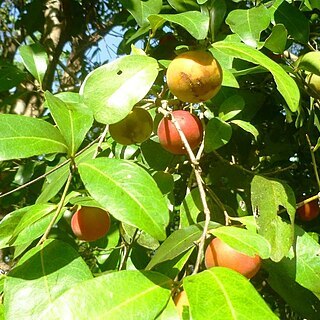Tree 13–25 m high, exudate yellow. Twigs flattened or terete. Leaves glabrous; petiole 8–20 (–30) mm long, 2.5–3 mm wide; lamina discolorous, coriaceous, elliptic to ovate or subcircular, (4–) 6.5–23 cm long, 2.8–12.3 cm wide, base attenuate, cuneate or obtuse, apex acuminate, acute, obtuse, retuse or emarginate; venation brochidodromous; secondary veins prominently or slightly raised above and below; submarginal veins on lamina underside 1–3 mm from the margin. Inflorescences terminal or axillary, axes 1–35 mm long. Flowers 15–18 mm diam.; sepals 4, orbicular; petals 4, elliptic to obovate, 10–13 mm long; stigma mass sessile, domed, 7–8 mm diam.; stamens in 4 stout phalanges, adnate to petals in male flower, pistillode present. Fruit a fleshy berry, globose or subglobose, apex rounded, 35–45 mm long, 43–45 mm wide, persistent stigma; fruiting calyx lobes 4, 2–3 mm long.
More
A tall shrub or small bushy tree. It grows to 6-13 m high and spreads 1-3 m wide. When the tree is damaged it produces a yellow exudate. The small branches are angular. The leaves are 10-16 cm long by 4-5 cm wide and leathery. They are dark green and have short thick leaf stalks. Flushes of new growth are often red. The flower cluster is produced in the axils of leaves. It is branched and stiff. The flowers are about 1 cm across and white. They have a strong scent. There are 4 thick petals. The fruit is a berry 3-3.5 cm across. It is oval, purple and fleshy. Two seed occur in a fruit. The seed are 3 cm by 2 cm. The flesh of the fruit is edible.


